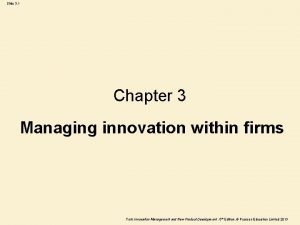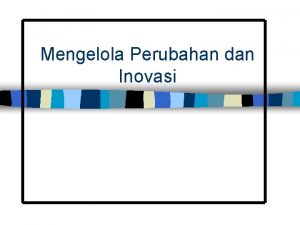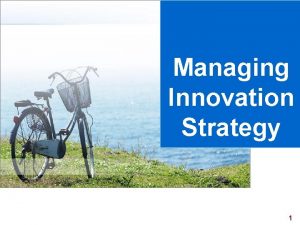Managing the Innovation Process Module summary Managing in









- Slides: 9

Managing the Innovation Process: Module summary Managing in Information-Intensive Companies Prof. Morten Hansen Sep. 17 2010

The problem: Established companies often do not innovate well n Mechanistic, exploitative: set up to execute on existing operations n n Short run, unit-focused, execution-oriented New businesses are different n n Exploratory, organic Different markets, business models/economics n n n E. g. , digital printing at RR Donnelley Different people and skills required Different metrics needed Solutions need to balance exploration and exploitation

Solution 1: Take an Innovation Value Chain View innovation process as one whole process Idea generation => conversion => diffusion n Need to be good in all links n n Therefore, diagnose the weakest link n n Need to have a process for each phase Concentrate on improving the weakest link Understand that skills and tasks differ as move along the chain Idea generation: creativity, dreaming, seeing opportunities n Conversion: project management, manage organization n Diffusion: “Show me the money!” E. g. , RR Donnelley case exemplifies this n

Solution 2: Create hybrid structure that separates and integrates Fully integrated (in units) n Stand-alone Linked to units (integrates) n n Hybrid (linked to units +separate operations) Access to resources (money, people, expertise, customers, distribution), commitment from line, eventual transfer to line Separate operations (separates) n n Venture unit/corporate incubator (e. g. , IBM) or separate division (RR Donnelley) Entrepreneurial freedom, entrepreneurial people, higher riskreward incentives, different metrics.

Solution 3: Develop an innovation culture n Research shows four behaviors related to an innovation culture Creativity Implementation 1) Support for risk taking • Rewards for innovation • Management role models • Challenge the status quo 3) Teamwork • Share common goals • Open information 2) Tolerance of mistakes • Mistakes are normal • Being “safe” isn’t OK 4) Sense of Urgency • Fast decision making • No red tape • Once decided, full commitment Source: “The determinants of team-based innovation in organizations. ” Small group Research, vol. 34, 2003

Solution 4: Develop ambidextrous skill sets n Develop people to be good at both exploitation (running the existing business) and exploration (new business development) n n n Especially in sr. management teams Hire, promote and job-rotate to create as many people with ambidextrous skills as possible + Hire and develop people with either skill set n n Not all can have ambidextrous skills Thus need to have it at the aggregate organizational level => Ambidextrous in top management + some specializaton below

Solution 5: Change metrics for new business creations n Metrics used for existing businesses risk killing new businesses n n Short-term (e. g. , profit within a year at RR Donnelley) Financials, when they are not meaningful Market share, when markets don’t even exist But metrics needed to measure progress n n Milestones (e. g. , IBM) Depends on stage in process n n Early development: technology progress, design wins Later: sales, customer targets etc.

Solution 6: new business champions need to develop political skills n Innovation is a messy process, requiring project champions to navigate the social and political landscape in a company (e. g. , Dow Chemical case) n n n Manage higher-ups Manage larger organization Do not only use rational arguments n n i. e. , do not only argue that “it’s a good project”, but understand the motives of other people and units Use influence tactics: Build internal coalitions, build momentum, “sell” to others in the organization, enlist supporters, trade favors with others (norms of reciprocity), ingratiate, etc.

Solutions encompass several “levers”: they need to be aligned “Hard” “Soft” Culture: Risk/Failure + Implementation Skills: Ambidextrous Politics/Social: Use influence tactics Structure: Separate + Integrated Aligned Process: Innovation Value Chain Metrics: Hitting milestones, Not strict financials
 Innovation for the sake of innovation
Innovation for the sake of innovation Radical innovation vs disruptive innovation
Radical innovation vs disruptive innovation Pearson's uncertainty map
Pearson's uncertainty map 2 metafora mengenai proses perubahan
2 metafora mengenai proses perubahan Managing change and innovation
Managing change and innovation Strategic issues in managing technology and innovation
Strategic issues in managing technology and innovation Chapter 13 managing change and innovation
Chapter 13 managing change and innovation C device module module 1
C device module module 1 Module 4 topic 5 turnabouts and parking
Module 4 topic 5 turnabouts and parking Module 4 topic 1 assessing and managing risk
Module 4 topic 1 assessing and managing risk
















